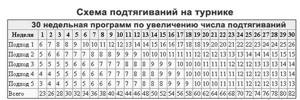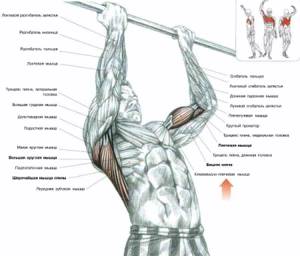An integrated approach to training
Pull-ups, like any other exercise, can provide little in terms of muscle growth without a number of other measures.
Number one among these measures is nutrition. Next comes sleep and lifestyle in general. Let's start with nutrition to keep things short and clear.
Eat like an elephant - you will be huge and strong
There is meaning and a piece of truth in this funny phrase. Eating a lot of calories will actually make you gain weight. If you do not exercise, fat will accumulate. If, with an excess of calories, you load the muscles to the fullest extent, it is the muscles that will grow.
And there is one more condition - the quality of the food. Depending on what is contained in the food, subcutaneous and visceral fat or muscle will grow more.
If your food is rich in protein, the muscle part of the body will receive building material. But without energy, muscles cannot work effectively. High-carbohydrate foods, in turn, are rich in energy contained in the chemical bonds between molecules. This energy will be spent during training, and its excess will be stored in the form of glycogen and used for fat synthesis. But there is little building material for muscles in carbohydrate foods, so they have nothing to grow from.
Hence the conclusion - you need both proteins and carbohydrates. Everything is simple here - there is material, there is energy - synthesis occurs. This is how our body works.
The best option is to calculate your daily diet in calories and grams of proteins, carbohydrates and fats. There is a lot of information in open sources about how to do this.
- Your first task is to make sure that the calories expended per day are less than the calories consumed. Then the excess calories will give growth.
- The second task is to decide how much protein you need to consume per day based on your body weight. And provide yourself with such a diet. Remember that protein is not only found in meat. Among other things, these are dairy products, eggs, fish and much more.
Compliance with the optimal amount of calories and BJU ratio will be called proper nutrition. Stick to it, and gaining mass on the horizontal bar will not take long.
However, it is worth saying that any organism has limits. Muscle can grow at a certain rate. And this speed at the first stage is limited by the concentration of growth hormones and testosterone. Each person's rate of muscle growth is individual. Therefore, do not be equal to your comrades - track your and only your results.
Lifestyle
By lifestyle I mean the ratio of sleep and wakefulness within a day, as well as physical activity.
Everything is clear with activity - the higher it is, the higher the calorie intake should be and vice versa.
You need enough sleep to feel good and energetic during the day. Some people say - sleep more and everything will be fine. But what matters is not so much the number of hours, but the quality of sleep.
After all, after a very long sleep a person may feel “broken.” This means that you either slept poorly or simply went over your quota. Be guided by sensations. Your task is to choose the number of hours that will give you the most comfortable feeling.
If you have mastered all of the above, let's start looking at pull-ups!
Mass pull-up diagram
When talking about how to gain muscle mass on the horizontal bar, you should clarify that you will need to do different variations of pull-ups and muscle-ups.
To start, focus on pull-ups. This will be a kind of preparation. For example, you can exercise three times a week.
Let's designate training days with numbers:
- Pull-ups with a reverse narrow grip in three approaches for the maximum number of times (but not less than 10 per approach).
- Pull-ups with a wide straight grip on the back, the same amount.
- Pulls with a classic medium grip. We do “unloading”, 3 sets of 10 times.
The last day should be easy so that your muscles do not overwork. Try doing this for a month. In 30 days you will complete approximately 12-13 workouts, then, depending on your results, you can start working on weight.
Yes, you understood correctly, you will need to use weights.
Gradually begin adding additional pounds to your weight. These could be water bottles tied to your waist, a backpack with weight plates, or a classic weight vest. Or maybe you will use leg weights? Your choice.
The training scheme remains the same. On the first and second days, we reduce the number of repetitions in the approach to 6-8. The weight should be such that the last pull-up is difficult for you. The third day is left as a “fasting” day. That is, we work 10 times without weights or with light weights.
We perform all movements slowly, without jerking. If you weigh too many pounds, you won't be able to do all the reps smoothly. You'll have to move in jerks. People with connective tissue defects are at risk of pulling the muscles of the forearm and shoulder. Be aware of these risks and avoid sudden movements.
In parallel with weighted pull-ups, you need to begin to master the power output in different variations. It is better to practice outdoors, since the ceilings prevent you from fully performing exercises indoors.
Exercise on the crossbar regularly, fight laziness - then and only then will you get results. But there is still a nuance on which your progress depends.
There is one problem with exits - if you don't understand the technique, it will be difficult to make them. And it doesn't matter how strong your hands are. Everything will depend on the coordination of the muscles of your body.
Program for beginners

pull-up diagram for beginners
The optimal option is to train 4 times a week, 2 times in a light mode, 2 times in a heavy mode. Alternation doesn't matter. With a low level of endurance and physical fitness, it is necessary to perform fewer approaches, but increase the rest period. For each specific exercise, you will need to complete 4 approaches with the number of repetitions that your own capabilities allow.
Pull-ups:
- Negative pull-ups. You will need a stand (for example, a bench or stool), which should be placed under the horizontal bar. You need to climb onto the stand and grab the bar with a reverse grip, leave the stand without straightening your arms. Measured for 8 counts, you need to lower yourself onto straight arms. Get back up onto the rack and repeat.
- Jumping pull-ups. You need to stand under the bar and raise your arms towards it. Jump up and grab the horizontal bar while jumping with your arms bent at the elbow joint. You need to slowly straighten your upper limbs, release the horizontal bar and perform it again, starting again with a jump. The current point is that over time, you need to jump lower and apply more force with your hands to take the initial position.
- Pull-ups with rubber on top. It is necessary to fix the shock absorber on the crossbar. Grab the horizontal bar with a reverse grip, and rest your foot against the shock absorber loop. Using the help of rubber, you need to pull yourself up. At a calm pace, return to the starting position and repeat.
What else is good about pull-ups?
Few people know the benefits of pull-ups on a horizontal bar.
You work with your body weight. The body is genetically optimized to work with its own weight. If you can do different strength exercises on the horizontal bar, then your muscles are in excellent condition. If not, it’s worth thinking about.
When you hang from the bar, your spine does not experience compression. On the contrary, it is stretched. This is useful from the point of view of preventing pinching and pinching. The muscles hold the vertebrae, pulling them towards each other, but if you relax, you can achieve a healing effect. If you work out in the gym and perform a vertical load with heavy weights, you must hang on the horizontal bar for at least 60 seconds a day, trying to completely relax your back and abs.
Of course, when you actively pull yourself up, you won’t be able to relax. But there is another feature here - firstly, you disperse blood throughout the body, and secondly, in fact, you remind the muscles why they are needed.
These are the benefits of pull-ups even without weights.
Pull-up technique

- Maintaining correct body position . You need to fix your legs, you can fix them together and bend your knees at an angle of ninety degrees. In this position, lifting is carried out due to the strength of the arm muscles (the help of the legs and pelvis is excluded), and the work of the back is felt.
- Frequency and effort. To thoroughly work out the muscles, the exercise is best performed slowly, that is, lifting and lowering the body should be done at the same speed and evenly. There should be no jerking when moving. Hands must be kept tense. Muscle mass should be felt.
- Correct breathing: when ascending, inhale evenly, when lowering, exhale.
Precautionary measures
There are also a number of reasons why some people find pull-ups difficult. The main one is weak connective tissue, prone to injuries and sprains.
There is a solution, friends: warm up well and work very carefully with weights. The latter means that you need to add weight gradually. So gradually that your patience may not be enough. For example, you started doing pull-ups with 2 extra kg. Exercise with this weight for a week. Even if it becomes easy for you to exercise, increase the number of pull-ups, not the weight. After a week, add 1 kg. And so on. If you rush, you will get injured and forget about pull-ups for a long time.
Take warming up seriously. Without it, you risk injury.
The next problem that can lead to injury is a weak grip or a slippery bar. A weak grip needs to be strengthened - this is done by periodically hanging on the horizontal bar, using an expander or other exercises.
A slippery horizontal bar can prevent you from fully exercising. The solution is to use chalk, magnesium, or wear special gloves. Any of the above methods will help you.
The nuances of gaining mass on the horizontal bar
Pull-ups target the biceps, shoulders, and back. The lower back, legs, triceps do not experience stress. This means that only the arms in front and the back will develop.
In addition, weight gain will not proceed as quickly, since the load does not affect the entire muscle mass of your body.

It makes sense to add dips (chest and triceps) and hanging leg raises (abdominals) to your outdoor workouts.
But leg training gives a good increase in mass due to the production of large amounts of testosterone. Here the horizontal bar and parallel bars will no longer help. It's better to get a pair of good dumbbells or a barbell. Or go to the gym.
Be prepared for the fact that pull-ups alone will not increase the mass as much when performing a set of basic exercises with iron.
In conclusion, I would like to say that it happens that you do everything correctly, follow the technique. But you don’t have the perseverance to overcome yourself every time and go to training, despite laziness and other things. But then there will be no progress either. Remember that building muscle comes through discipline and perseverance. Push yourself, try to do more repetitions than you can. Constant self-education is the key to success!
Program for experienced

Represents standard pull-ups in various variations. They should be started when you have already mastered 8 to 10 pull-ups with a direct grip. The ideal is to do 25 to 30 reps of each exercise before attempting the advanced routine.
Pull-ups:
- Reverse grip. Starting position - you need to hang on the horizontal bar, grip with your palms towards you. The eyes look up, you should bend slightly in the chest. Execution - pull yourself up, bend your arms so that your chin overcomes the level of the horizontal bar. Slowly return to the starting position and repeat. Regularity is the key to effective prevention of shoulder joint injuries.
- Direct grip . Starting position – grip with your palms towards you at shoulder width or slightly wider. You need to hang on straight arms, eyes looking up. Execution - bending your arms at the elbow joints, you need to rise up, trying to raise your chin above the horizontal bar. While controlling the execution, return to the starting position and repeat.
- Wide grip. Starting position - you need to hang on the horizontal bar, grab it with a grip wider than your shoulders. Bringing your shoulder blades together, you need to pull yourself up and try to reach the horizontal bar with your upper chest. Slowly return to the starting position and repeat.
- Different grip. Starting position - you need to grab the horizontal bar with a different grip - the palm of one hand “looks” at you, and the other - away from you. Arms straight, slightly arched in the chest and eyes looking at the bar. Execution – bending your arms, pull yourself up to the maximum limit level. Return to the starting position and repeat.
To improve performance, it must be combined with a bench press. Later, it is recommended to add weighting, for example, attach 1 or 2 discs to your belt. Frequency – 3 to 6 workouts on a weekly basis, 40 to 50 minutes each. It would be enough.
Visible results will be achieved within a period of 2 to 4 months. Muscle volume will significantly increase, muscle strength and overall endurance of the body will increase.
How to become taller?
If such a goal is set, then you will need to perform certain exercises on the horizontal bar that will help increase it.
You need to pull yourself up, then drop sharply. After this, in a hanging position, make several rotational movements.











